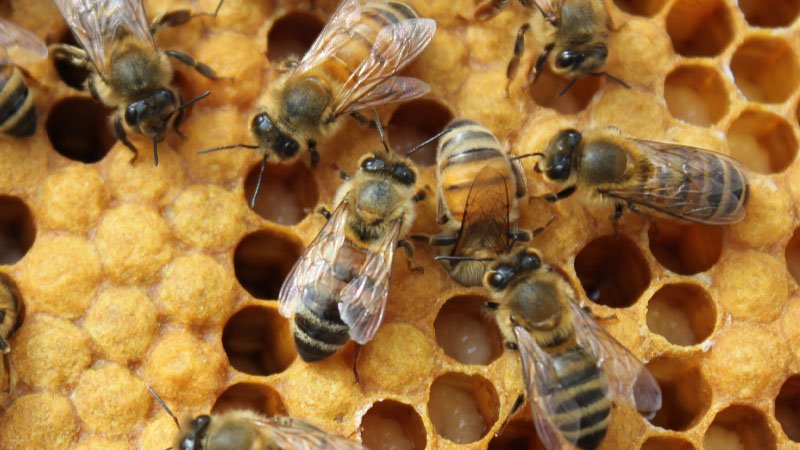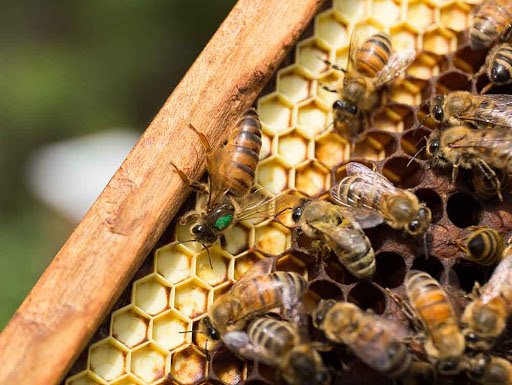
A decade ago, bee hives were scarce on golf courses and about the only resource for superintendents who did dabble in raising them was the occasional university field day presentation.
Things have changed since University of Kentucky entomologist and former USGA Green Section Award recipient Dan Potter, Ph.D., helped establish the first Operation Pollinator zone on a U.S. golf course at Griffin Gate Golf Club in Lexington in 2011. At the UK turfgrass field day the following year, Potter and his graduate students promoted to a spartan audience the benefits of keeping bees and shared the challenges facing them, such as parasite pressure, habitat loss and pesticide use.
Since then, beekeeping on golf courses is more popular than ever, and growing native pollen-producing flowers to feed them and attract other species has been a growing trend. has been a and fortunately the resources available to superintendents (and others) on the topic is voluminous.
Web sites, like Honey Bee Health Coalition offer resources for keeping bees and managing pests. And university bee labs at the University of Florida and Ohio State provide a wide range of tools, such as bee-identification guides, scientific research and outreach efforts including workshops and webinars.
"It's great to hear that beekeeping and supporting pollinators is becoming more common on golf courses," Ohio State entomologist Reed Johnson, Ph.D., said. "This is something that probably requires more research – how to best manage bees and bee forage on golf courses."
While some keep bees on golf courses no doubt to monetize honey production, others do it to help struggling bee populations, and many do it for some combination of both.
 Jeff Sexton has been keeping bees at Evansville Country Club in Indiana for five years. His hives are thriving, and his members love having them and learning more about them. He also educates the rest of the Evansville community on how he and his team work to promote environmental stewardship on the golf course, not destroy it.
Jeff Sexton has been keeping bees at Evansville Country Club in Indiana for five years. His hives are thriving, and his members love having them and learning more about them. He also educates the rest of the Evansville community on how he and his team work to promote environmental stewardship on the golf course, not destroy it.
"My members have always trusted my judgment on various projects," Sexton said. "We educate them through email and newsletter writings. We have also educated the public through news media. We have even had Congressman Buschon here on site as well. We have had ours since 2016 and never had a golfer stung! Hive location relative to golf is important. We sell honey to our membership every year. They love it."
Honey bees are responsible for pollinating a host of common foods that many take for granted yet would cease to exist without their help. That list includes almonds, apples, apricots, avocados, bananas, blackberries, blueberries, cashews, cherries, chocolate, coconut, coffee, cranberries, grapes, grapefruit, kiwifruit, mangos, melons, papayas, peaches, pears, pumpkins, raspberries, strawberries tomatoes and vanilla, just to name a few.
For all the good they do, bees also are threatened by pesticides, parasites and loss of habitat.
Imagine for a moment a world without coffee.
Agriculture is a $50 billion industry in California. The state produces one-third of the country's vegetables and two-thirds of its fruits and nuts, and relies on the work of honey bees for much of that output.
Bee decline in the U.S. began in the mid-1980s, according to Purdue University entomologist Greg Hunt, Ph.D. That's about the same time the invasive Varroa mite, public enemy No. 1 in the western honey bee world, arrived in the U.S. Native to the Korean peninsula, where it parasitizes the Asian honey bee. The Asian honey bee can tolerate the mite, but its western cousin cannot.
Summer management of Varroa is critical so that the bees reared in late summer are healthy and stand a good chance of surviving into the following spring.
Within two years of their arrival in the U.S. in 1987, the mites wiped out an estimated 90 percent of the non-native bee populations in California. The parasites are so deadly that they have become known as Varroa destructor.
Female mites lay their eggs in the honey bee cells where they feed on the pupae and are attached to the adult bees when they emerge. Left unchecked, they can overwhelm and eventually wipe out an entire bee colony.
"Varroa is a serious and deadly pest of honey bees and needs to be controlled," Johnson said. "In colonies where Varroa are left unchecked, the colonies generally die in November (through) January.
"Summer management of Varroa is critical so that the bees reared in late summer are healthy and stand a good chance of surviving into the following spring."
Wild native bee populations are more hardy than their domesticated cousins. According to Bee Informed, managed colonies lose an average of 10 percent to 50 percent of their population each year. Losses are attributed to mites, weather and starvation.
"Starvation has always been a killer of bees over winter, and even before Varroa beekeepers would generally lose 10 to 20 percent of colonies because the bees ran out of accessible food," Johnson said. "Making sure the colony has a full deep box of honey - about 70 pounds - will help them survive the winter. We also feed bees with sugar bricks or cake fondant to make sure they don't run out of calories before spring flowers start to provide nectar.
"The rule of thumb is that one colony needs one acre of blooming plants, flowering throughout the season, in order to sustain themselves. Having enough flowers nearby can help ensure that the colonies have that 70 pounds of honey going into winter. Many colonies make a lot more honey, if they're in a good environment, making it possible for the beekeeper to collect honey for extraction and sale."


